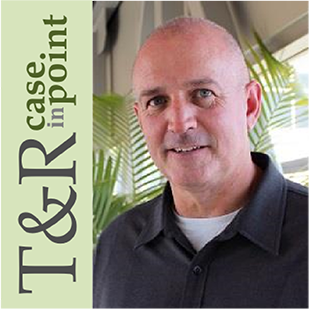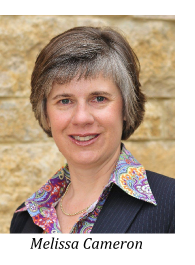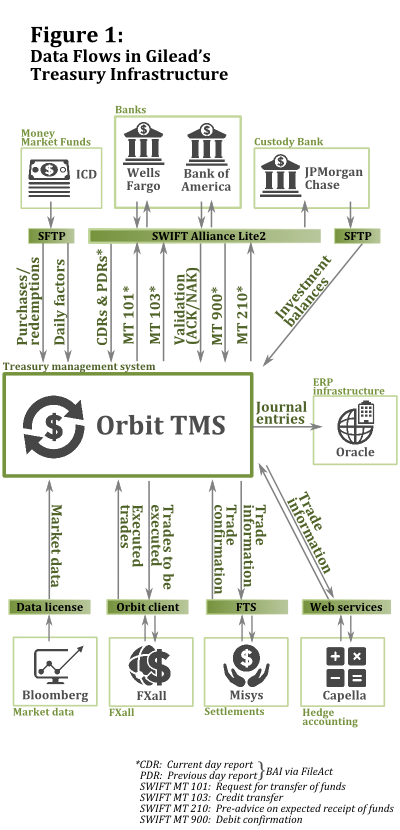 Twelve months ago, the treasury team at Gilead Sciences, Inc., a fast-growing biopharmaceutical business that develops and produces treatments for some of the world's deadliest diseases, faced some critical challenges. The company brings in close to $10 billion in annual revenue through operations in more than 30 countries. Yet its small treasury staff was spending more time on transaction processing than on analysis, and manual data entry put the company at risk for errors.
Twelve months ago, the treasury team at Gilead Sciences, Inc., a fast-growing biopharmaceutical business that develops and produces treatments for some of the world's deadliest diseases, faced some critical challenges. The company brings in close to $10 billion in annual revenue through operations in more than 30 countries. Yet its small treasury staff was spending more time on transaction processing than on analysis, and manual data entry put the company at risk for errors.
Treasurer Brad Vollmer decided to revamp his department's technology infrastructure to automate many of his team's core duties. He worked with Melissa Cameron, a Deloitte principal who specializes in treasury, to integrate cash management and foreign exchange (FX) systems from forecasting to settlement to accounting. Now many of the previously tedious treasury tasks are automated, reducing the chances of errors and freeing up Vollmer's staff for more value-added work. Treasury & Risk sat down with Vollmer and Cameron to discuss the project and its results.
T&R: What were the challenges that your treasury team faced in your legacy environment?
Brad Vollmer: Well, our treasury ops team, which handles FX, cash management, capital markets, and planning, consists of eight people. For a company with a market cap approaching $90 billion, that's a pretty small treasury staff. We have approximately 130 bank accounts with 18 banks in 30 countries. We have more than $3 billion worth of securities invested in money market funds, government notes, and corporate securities, both in the U.S. and offshore. We have $7.5 billion in debt, which includes a revolver and convertible notes, as well as straight debt. And our FX portfolio, which we use to hedge risks in 12 different currencies, is worth $4 billion. So the treasury ops team needs to be very efficient.
T&R: I take it that your treasury processes weren't especially efficient before?
BV: We had the common problem that a lot of our processes were manual and very labor-intensive. Multiple people would have to enter the same data into different systems. This meant that, number one, our processes were potentially prone to error. And secondly, we were spending a lot of time doing non-value-added work again and again for the same wire or the same transaction. It was all very cumbersome. We wanted to move up the value chain to straight-through processing so that our treasury ops team could spend more time on analytics instead of processing.
T&R: And that was because the information wasn't automatically consolidated in one place? You guys had to go in and manually get it?
BV: Yes. For example, to determine our global cash position, our colleague in Europe would log into our wire systems, pull all the data, and put it in a spreadsheet. Then he'd have to log into our ICD portal and do the same thing for all our money fund investments. He'd grab all that information, put it in a spreadsheet, and send it to the U.S. Then the U.S. team would do the same for North America and put it all together in a report. They did that once a week, and it took a good day's worth of work.
Melissa Cameron: Brad, by the time you got it, it was out of date.
BV: That's right. After all that effort, the information would be a day old by the time I got it.
T&R: What were some other processes that needed automating?
BV: One was just sending and receiving wire transfers. Treasury would get a request for a wire. We would enter it in a tracking spreadsheet so we knew what was sent. We would enter it in our wire system. And then we would send the same information to accounting, who would re-enter it into their system. Even for a share repurchase wire, the information was flowing in different directions and re-entered a number of times.
An even better example was our process for FX trades. Our FX forecasting process is pretty good, but we were very inefficient in processing FX trades. We would key the data into Bloomberg to execute the trades. Then we would put that same data into our confirmation system, Misys, where it would be confirmed. Then we would re-enter it all again into our wire systems for settlement. We would send the same information to an accounting system called Capella for ASC 815 purposes, and when the accounting would come out of Capella, someone would manually input it into the G/L [general ledger]. So the same data was re-entered over and over again. Some of these steps did involve spreadsheet uploads, but they still required someone to touch the data. We wanted to get away from that, both to save people time and to reduce the risk that mistakes could be made.
T&R: It's clear why you wanted to improve your treasury processes. How did you get the ball rolling, though, on making a wholesale change?
BV: Well, when I arrived here, Gilead was in the midst of an ERP [enterprise resource planning] project, where we moved from JD Edwards to Oracle. As soon as that project ended, we wanted to start an automation project in treasury. At the very beginning, we got IT involved, as well as accounting and other areas of finance.
 MC: Brad also made a really good call to get internal audit [IA] to help right from the get-go, to make sure they were embedded in the overall project, including the design process, identifying the key controls. Typically, internal audit comes in at the back end, and they either approve or say, 'No, go back and do some extra work.' Before the system went live, Brad had the comfort of knowing that IA had signed off on the controls. Additionally, we didn't have to redo any design elements because internal audit got involved late in the process. This is a best-practice approach.
MC: Brad also made a really good call to get internal audit [IA] to help right from the get-go, to make sure they were embedded in the overall project, including the design process, identifying the key controls. Typically, internal audit comes in at the back end, and they either approve or say, 'No, go back and do some extra work.' Before the system went live, Brad had the comfort of knowing that IA had signed off on the controls. Additionally, we didn't have to redo any design elements because internal audit got involved late in the process. This is a best-practice approach.
T&R: What were your key criteria for your new treasury solution?
BV: We agreed that we were looking for a system that would provide flexibility in customizing it to make it as useful as possible for us. I think sometimes the big treasury service providers can be too bureaucratic. You have to fill out a change request and wait to see if it gets approved, which might take months. We wanted a treasury service provider that had actual treasury experience, but that could make decisions quickly, with a tool that is flexible enough and robust enough that we can make changes and move on. We selected the cloud-based Orbit treasury management system.
During our ERP implementation, we had been talking with Deloitte. I've known Melissa for a long time, and I have a lot of faith in her and her team. We didn't use Deloitte to help us select the system, but once we had made decisions about the direction we wanted to go, Deloitte helped validate those decisions.
MC: We did give Brad and his team some pointers and perspective before they locked down that decision. But it was nice that when we jumped into this project, we knew what we were going to do. The only thing that came up a bit later was Gilead's decision to use SWIFT Alliance Lite2 to connect to the SWIFT network.
T&R: So, how does an FX trade now work?
BV: Now we upload our exposures into Orbit, which automatically exports them into FXall. Once a trade is executed in FXall, Orbit automatically ships it to Misys. Then, once it's been confirmed in Misys, it comes back into Orbit with a 'confirmed' status. Next, Orbit actually generates the wires to settle the trade. Instead of rekeying any data, someone just pushes a button and tells SWIFT Alliance Lite2 to release the wires. Then that same information flows automatically into Capella, our accounting system for FAS 133. At month-end, it comes back into Orbit, where it all gets consolidated, and Orbit interfaces directly with our Oracle G/L. At every step, the data moves automatically.
 MC: From a broad perspective, I see this as leading practice. Treasury teams that are doing all these things manually are exposing their organization to a lot of operational risks. From a control perspective, this system is a huge step forward for the Gilead treasury team. I think all companies with $1 billion or more in revenue should really be aiming toward system automation like this.
MC: From a broad perspective, I see this as leading practice. Treasury teams that are doing all these things manually are exposing their organization to a lot of operational risks. From a control perspective, this system is a huge step forward for the Gilead treasury team. I think all companies with $1 billion or more in revenue should really be aiming toward system automation like this.
T&R: What about the weekly reports on your cash position? What do those look like today?
BV: I can tell you right now, on any given day at any given time, what our global cash position is—almost down to the penny. What used to be an all-day event now happens with just a click of a button.
T&R: Can you estimate how much time your staff is saving on the weekly cash reports, FX trades, and other treasury activities?
BV: Well, it's hard to quantify the time because we didn't let anyone go. What we did is re-task them. They've moved up the value chain because they're spending more time on analytics, on solving the real challenges we face, rather than just keying in data. That said, on a monthly basis, we're probably saving around four days of time on FX processing activities. And then on a weekly basis, we've eliminated about a day of busy work because the staff no longer has to produce the cash report.
So we are achieving time savings. But the key for me is, I sleep better at night because I know the chance of a fat finger causing problems with the data is much lower.
MC: And it's real-time.
BV: Right. I get information in real time now. I don't have to wait for the weekly cash report to know where the cash is. The same goes for foreign exchange. If something happens with a counterparty, I can run a report at my desk, right away, to see what our exposure is to that bank. That's huge.
And there's one more important benefit: The automated treasury solution is much more scalable. Gilead is growing incredibly fast, and we're moving into a bunch of new markets. Because we're working directly with SWIFT, our system is bank-agnostic. When we need to scale, we can just pick the best bank in the region, set up an account, and we're live pretty quickly.
T&R: How long did it take to roll out this solution?
BV: We got this done in seven and a half months, from the kickoff until the solution was live, including contracting with SWIFT and our relationship banks. We went into it with the assumption that this would not be like every other treasury implementation. We made sure to scope it right up front so we could move as quickly as possible. We had really good project management from Deloitte, with things running in parallel streams.
T&R: What kinds of activities were you doing in parallel that normally might happen serially?
MC: We used an agile approach to software development. We were very discerning about determining what Gilead really wanted, and what they didn't need. And as we configured the Orbit solution, we would essentially be in design sessions with Orbit, with Gilead's core treasury, accounting, and internal audit team. Meanwhile, parallel actions were going on around defining and cleaning up static data and contracting with the banks around SWIFT messages.
BV: We had different streams going. So as we worked on SWIFT, we didn't let that slow down the FX side or our work with ICD or even Misys. We knew what we needed to do, and we didn't let the queue back up.
 MC: Every day was a new adventure, and projects often don't happen like that. They're often very structured, where you need to dot the i's and cross the t's on everything in one phase before you can move into the next phase. But this time we moved very fast. I think the project would have taken 40 percent longer, maybe more, if we had we gone with a larger vendor with a less agile approach.
MC: Every day was a new adventure, and projects often don't happen like that. They're often very structured, where you need to dot the i's and cross the t's on everything in one phase before you can move into the next phase. But this time we moved very fast. I think the project would have taken 40 percent longer, maybe more, if we had we gone with a larger vendor with a less agile approach.
T&R: Gilead was an early adopter of SWIFT Alliance Lite2. How has that worked out?
MC: Gilead was one of the first companies in the world to implement Alliance Lite2. It has been a phenomenal success.
BV: I'm a big fan of SWIFT Alliance Lite2. What it does is it gives you one throat to choke. You're dealing directly with SWIFT, and it is all cloud-based. I don't see any downside to it.
MC: Clearly the market has moved so that advanced corporate treasury departments are going to pick either a service bureau or SWIFT Alliance Lite2 for bank connectivity, wherever possible. Because SWIFT is owned by over 100 banks, it offers a strong business continuity advantage.
Business continuity is also an issue when you're choosing a treasury system solution provider, but I think an in-house solution rarely makes sense these days. For a midsize to large business where it might be a challenge to get the right IT resources to support a treasury management system, it makes a lot more sense to have a hosted solution. If you go with a cloud-based solution, you can either have a dedicated environment or one that gets upgraded when everyone else gets upgraded. There are pros and cons to both of those approaches. But a cloud-based treasury management system is a smart solution for companies that don't want to build a big IT organization for treasury.

© 2025 ALM Global, LLC, All Rights Reserved. Request academic re-use from www.copyright.com. All other uses, submit a request to [email protected]. For more information visit Asset & Logo Licensing.




